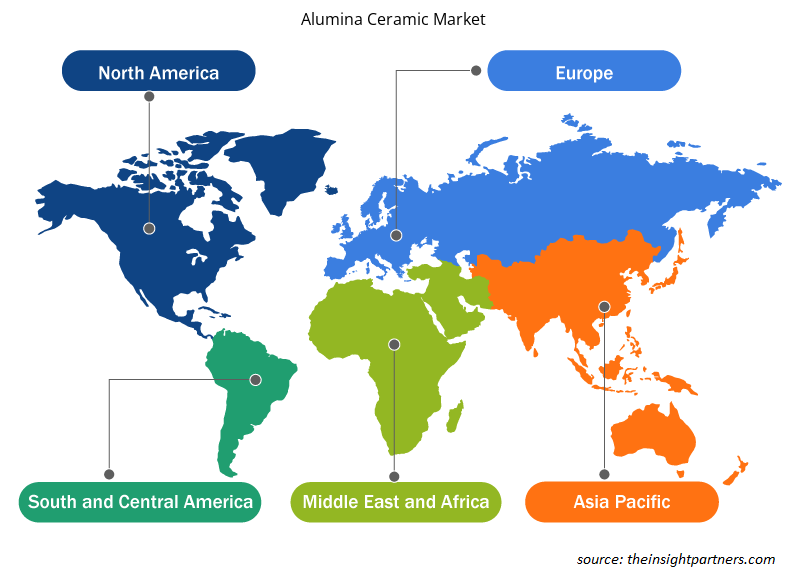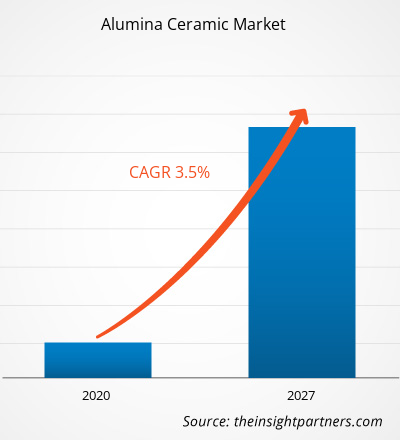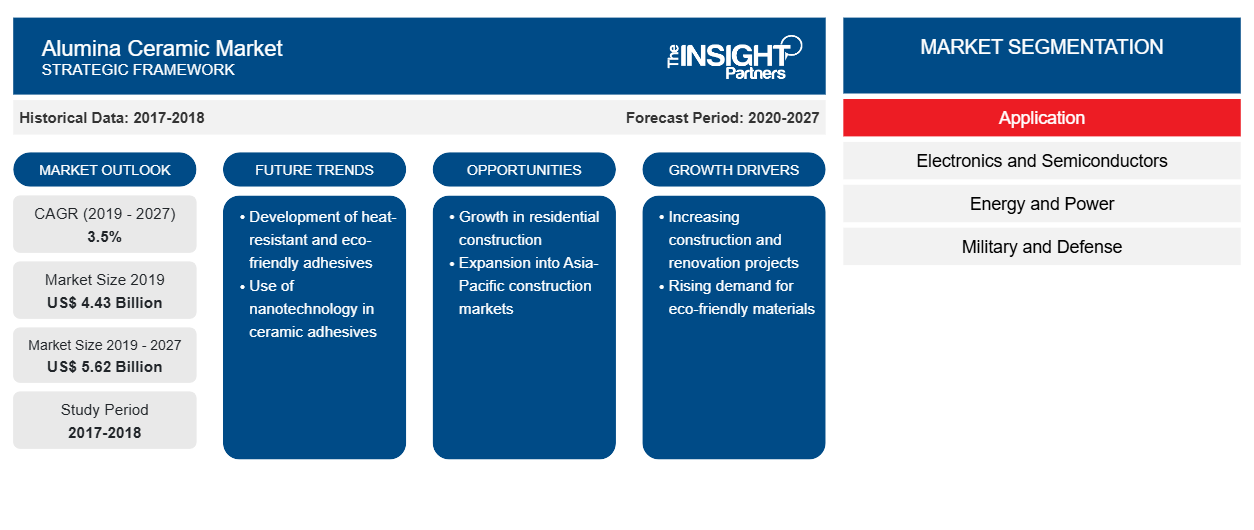Der Markt für Aluminiumoxidkeramik hatte im Jahr 2019 einen Wert von 4.428,90 Millionen US-Dollar und soll bis 2027 einen Wert von 5.615,27 Millionen US-Dollar erreichen; von 2020 bis 2027 wird mit einer durchschnittlichen jährlichen Wachstumsrate von 3,5 % gerechnet.
Aluminiumoxidkeramik ist die fortschrittlichste technische Keramik, die hervorragende elektrische Isoliereigenschaften in Kombination mit hoher Härte und guter Verschleißfestigkeit bietet, jedoch eine relativ geringe Festigkeit und Bruchfestigkeit aufweist. Aluminiumoxidkeramik ist normalerweise weiß, kann aber auch rosa (mit 88 % Aluminiumoxid) oder braun (mit 96 % Aluminiumoxid) sein. Hochreine Aluminiumoxidkeramik ist ideal für Umgebungen, in denen Verschleißfestigkeit und Korrosionsbeständigkeit erforderlich sind. Sie weist eine überragende thermische Stabilität auf, was bedeutet, dass sie häufig in Bereichen eingesetzt wird, in denen eine hohe Temperaturbeständigkeit wichtig ist. Aluminiumoxidkeramik ist ein bevorzugtes Material für Aluminiumoxid-Verschleißteile. Die nachgewiesene Verschleiß- und Hitzebeständigkeit von Aluminiumoxid-Verschleißteilen macht sie für die Herstellung verschleißfester Komponenten geeignet.
Im Jahr 2019 war der asiatisch-pazifische Raum der größte Markt für Aluminiumoxidkeramik. Das exponentielle Wachstum in Industriezweigen wie Automobil, Medizin und anderen hat die Nachfrage nach Aluminiumoxidkeramik beeinflusst. Asien ist einer der führenden Märkte für die Herstellung von Elektro- und Elektronikartikeln. Aluminiumoxidkeramik weist eine hohe Festigkeit und Steifigkeit, thermische Stabilität, Verschleißfestigkeit, Härte, niedrige Dielektrizitätskonstante, Korrosionsbeständigkeit, hervorragende dielektrische Eigenschaften und chemische Beständigkeit auf. All diese Eigenschaften treiben den Markt für Aluminiumoxidkeramik im asiatisch-pazifischen Raum an.
Der Ausbruch von COVID-19 wurde erstmals im Dezember 2019 in Wuhan (China) gemeldet. Im Januar 2021 gehörten die USA, Indien, Brasilien, Russland, Frankreich, das Vereinigte Königreich, die Türkei, Italien und Spanien hinsichtlich bestätigter Fälle und gemeldeter Todesfälle zu den am schlimmsten betroffenen Ländern. Laut den jüngsten Zahlen der WHO vom Januar 2021 gibt es weltweit ca. 83.322.449 bestätigte Fälle und insgesamt 1.831.412 Todesfälle. Der Ausbruch wirkt sich aufgrund von Ausgangssperren, Reiseverboten und Geschäftsschließungen nachteilig auf die Volkswirtschaften und Industrien zahlreicher Länder aus. Die globale Chemie- und Werkstoffindustrie ist einer der wichtigsten Wirtschaftszweige, die unter schwerwiegenden Störungen wie Unterbrechungen der Lieferkette, Absagen von Technologieveranstaltungen und Büroschließungen leidet. China beispielsweise ist das globale Produktionszentrum und der größte Rohstofflieferant für verschiedene Industrien und zugleich eines der am schlimmsten betroffenen Länder. Die Schließung zahlreicher Werke und Fabriken in China schränkt die globalen Lieferketten ein und stört die Produktionsaktivitäten, Lieferpläne sowie den Verkauf verschiedener Chemikalien und Werkstoffe. Verschiedene Unternehmen haben bereits mögliche Verzögerungen bei Produktlieferungen und einen Einbruch des zukünftigen Verkaufs ihrer Produkte angekündigt. Darüber hinaus behindern die von Ländern in Europa, Asien und Nordamerika verhängten weltweiten Reiseverbote die Möglichkeiten für geschäftliche Kooperationen und Partnerschaften. All diese Faktoren behindern die Chemie- und Materialindustrie und wirken somit als hemmende Faktoren für das Wachstum verschiedener mit dieser Branche verbundener Märkte.
Passen Sie diesen Bericht Ihren Anforderungen an
Sie erhalten kostenlos individuelle Anpassungen an jedem Bericht, einschließlich Teilen dieses Berichts oder einer Analyse auf Länderebene, eines Excel-Datenpakets sowie tolle Angebote und Rabatte für Start-ups und Universitäten.
-
Holen Sie sich die wichtigsten Markttrends aus diesem Bericht.Dieses KOSTENLOSE Beispiel umfasst eine Datenanalyse von Markttrends bis hin zu Schätzungen und Prognosen.
Markteinblicke
Wachsende Nachfrage nach Aluminiumoxidkeramik in der Automobil- und Medizinindustrie
Aluminiumoxidkeramik weist eine hohe elektrische Isolierung, Säure- und Alkalikorrosionsbeständigkeit sowie Abriebfestigkeit auf. Fortschrittliche Keramik wird in einer Reihe von Bereichen eingesetzt, darunter Automobil- und Elektronikkomponenten. Die auf Aluminiumoxidkeramik basierenden Produkte wie Keramiklager, Gleitringdichtungen, Ventile und Sensoren werden im Automobilsektor eingesetzt. Beispielsweise eignet sich Yttrium-stabilisiertes Zirkonoxid – ein für seine hohe Festigkeit bekanntes Keramikmaterial – für Pumpenkomponenten wie Einspritzdüsen und Gleitringdichtungen für Motoren, die eine hohe Haltbarkeit erfordern. Darüber hinaus ist Aluminiumoxidkeramik kostengünstiger und langlebiger als Kunststoffe und wird in der Automobilindustrie häufig verwendet, da fortschrittliche Fertigungstechnologien für Autokomponenten hochwertige Materialien zu einem erschwinglichen Preis erfordern. Darüber hinaus kann Keramik eine Vielzahl von elektrischen Eigenschaften aufweisen, von Isolatoren über Widerstände bis hin zu Halbleitern. Breite Keramikisolatoren, die Hochspannungsleitungen tragen, bestehen aus Aluminiumoxid. Keramikisolatoren wie Aluminiumoxid sind sehr starke Wärmeleiter. Sie können als Trägermaterial oder als Montagehalterungen verwendet werden, an die andere elektrische Komponenten angeschlossen werden. Beispielsweise werden elektronische Geräte in einem modernen Auto auf Aluminiumoxid platziert. Wenn die elektronische Einheit läuft, erzeugt sie Wärme und die Rückseite des Aluminiumoxids hält die Wärme ab. Dadurch können die elektronischen Geräte effizient arbeiten.
Anwendungseinblicke
Basierend auf der Anwendung ist der Markt für Aluminiumoxidkeramik in die Bereiche Elektronik und Halbleiter, Energie und Strom, Militär und Verteidigung, Automobil, Industrie, Medizin und andere unterteilt. Das Segment Elektronik und Halbleiter war 2019 mit dem größten Anteil Marktführer. Keramik auf Aluminiumoxidbasis wird aufgrund ihrer hohen elektrischen Isoliereigenschaften seit vielen Jahren in elektrischen Komponenten verwendet. Aluminiumkeramik wird in der Elektronikindustrie für Verbindungselemente, Widerstände und Kondensatoren verwendet, da es ein kostengünstiges und robustes Substratmaterial für hybride integrierte Schaltkreise, oberflächenmontierte Geräte und Sensoren ist. Darüber hinaus kann es auch für Halbleiteranwendungen wie PVD-, CVD- und CMP-Oxidätzen, Ionenimplantate und Photolithografie verwendet werden, um nur einige zu nennen. Darüber hinaus werden schwarze Aluminiumoxidkeramiksubstrate aufgrund der hohen Lichtempfindlichkeit der meisten elektronischen Waren hauptsächlich in integrierten Halbleiterschaltkreisen und elektronischen Produkten verwendet. Verpackungsmaterialien müssen starke Lichtschutzeigenschaften aufweisen, um die Sichtbarkeit der digitalen Anzeige zu gewährleisten. Die Verwendung von Keramik verringert das effektive Gewicht der montierten Elektronik und fördert die Keramik in der Elektro- und Elektronikindustrie. Somit treiben alle diese Faktoren das Wachstum des Marktes für Aluminiumoxidkeramik im Elektronik- und Halbleitersegment voran.
Einige wichtige Marktteilnehmer auf dem Markt für Aluminiumkeramik sind Saint Gobain SA; Xiamen Innovacera Advanced Materials Co., Ltd.; Ceramtec; Sentro Tech; LSP Industrial Ceramics, Inc; Morgan Advanced Materials; Kyocera Corporation; Dynamic Ceramic; BMW Steels Ltd; und Ferrotech Holdings Corporation. Wichtige Marktteilnehmer konzentrieren sich auf Strategien wie Fusionen und Übernahmen sowie Produkteinführungen, um die geografische Präsenz und die Verbraucherbasis weltweit zu erweitern.
Regionale Einblicke in den Aluminiumoxidkeramikmarkt
Die regionalen Trends und Faktoren, die den Markt für Aluminiumoxidkeramik im Prognosezeitraum beeinflussen, wurden von den Analysten von Insight Partners ausführlich erläutert. In diesem Abschnitt werden auch die Marktsegmente und die Geografie von Aluminiumoxidkeramik in Nordamerika, Europa, im asiatisch-pazifischen Raum, im Nahen Osten und Afrika sowie in Süd- und Mittelamerika erörtert.

- Erhalten Sie regionalspezifische Daten zum Markt für Aluminiumoxidkeramik
Umfang des Marktberichts über Aluminiumoxidkeramik
| Berichtsattribut | Details |
|---|---|
| Marktgröße im Jahr 2019 | 4,43 Milliarden US-Dollar |
| Marktgröße bis 2027 | 5,62 Milliarden US-Dollar |
| Globale CAGR (2019 - 2027) | 3,5 % |
| Historische Daten | 2017-2018 |
| Prognosezeitraum | 2020–2027 |
| Abgedeckte Segmente |
Nach Anwendung
|
| Abgedeckte Regionen und Länder |
Nordamerika
|
| Marktführer und wichtige Unternehmensprofile |
|
Dichte der Marktteilnehmer für Aluminiumoxidkeramik: Verständnis ihrer Auswirkungen auf die Geschäftsdynamik
Der Markt für Aluminiumoxidkeramik wächst rasant, angetrieben durch die steigende Nachfrage der Endverbraucher aufgrund von Faktoren wie sich entwickelnden Verbraucherpräferenzen, technologischen Fortschritten und einem größeren Bewusstsein für die Vorteile des Produkts. Mit steigender Nachfrage erweitern Unternehmen ihr Angebot, entwickeln Innovationen, um die Bedürfnisse der Verbraucher zu erfüllen, und nutzen neue Trends, was das Marktwachstum weiter ankurbelt.
Die Marktteilnehmerdichte bezieht sich auf die Verteilung der Firmen oder Unternehmen, die in einem bestimmten Markt oder einer bestimmten Branche tätig sind. Sie gibt an, wie viele Wettbewerber (Marktteilnehmer) in einem bestimmten Marktraum im Verhältnis zu seiner Größe oder seinem gesamten Marktwert präsent sind.
Die wichtigsten auf dem Markt für Aluminiumoxidkeramik tätigen Unternehmen sind:
- Saint-Gobain SA
- Xiamen Innovacera Fortschrittliche Werkstoffe Co., Ltd.
- Ceramtec
- Sentro-Technik
- LSP Industriekeramik, Inc.
Haftungsausschluss : Die oben aufgeführten Unternehmen sind nicht in einer bestimmten Reihenfolge aufgeführt.

- Überblick über die wichtigsten Akteure auf dem Markt für Aluminiumoxidkeramik
Bericht-Spotlights
- Fortschrittliche Branchentrends auf dem globalen Markt für Aluminiumoxidkeramik helfen den Akteuren bei der Entwicklung wirksamer langfristiger Strategien
- In Industrie- und Entwicklungsländern angewandte Strategien für Unternehmenswachstum
- Quantitative Analyse des globalen Marktes für Aluminiumoxidkeramik von 2017 bis 2027
- Schätzung der Nachfrage nach Aluminiumoxidkeramik in verschiedenen Branchen
- PEST-Analyse zur Veranschaulichung der Wirksamkeit der in der Branche tätigen Käufer und Lieferanten bei der Vorhersage des Marktwachstums
- Aktuelle Entwicklungen zum Verständnis des Wettbewerbsmarktszenarios und der Nachfrage nach Aluminiumoxidkeramik
- Markttrends und -aussichten in Verbindung mit Faktoren, die das Wachstum des Marktes für Aluminiumoxidkeramik vorantreiben und bremsen
- Entscheidungsprozess durch das Verständnis von Strategien, die das kommerzielle Interesse im Hinblick auf das globale Wachstum des Aluminiumkeramikmarktes untermauern
- Marktgröße für Aluminiumoxidkeramik an verschiedenen Marktknoten
- Detaillierte Übersicht und Segmentierung des globalen Aluminiumoxidkeramik-Marktes sowie seiner Dynamik in der Branche
- Marktgröße für Aluminiumoxidkeramik in verschiedenen Regionen mit vielversprechenden Wachstumschancen
Aluminiumoxidkeramik-Markt, nach Anwendung
- Elektronik und Halbleiter
- Energie und Leistung
- Militär und Verteidigung
- Automobilindustrie
- Industrie
- Medizin
- Sonstiges
Firmenprofile
- Saint-Gobain SA
- Xiamen Innovacera Fortschrittliche Werkstoffe Co., Ltd.
- Ceramtec
- Sentro-Technik
- LSP Industriekeramik, Inc.
- Morgan Advanced Materials
- Kyocera Corporation
- Dynamische Keramik
- BMW Steels Ltd
- Ferrotech Holdings Corporation
- Historische Analyse (2 Jahre), Basisjahr, Prognose (7 Jahre) mit CAGR
- PEST- und SWOT-Analyse
- Marktgröße Wert/Volumen – Global, Regional, Land
- Branchen- und Wettbewerbslandschaft
- Excel-Datensatz
Aktuelle Berichte
Erfahrungsberichte
Grund zum Kauf
- Fundierte Entscheidungsfindung
- Marktdynamik verstehen
- Wettbewerbsanalyse
- Kundeneinblicke
- Marktprognosen
- Risikominimierung
- Strategische Planung
- Investitionsbegründung
- Identifizierung neuer Märkte
- Verbesserung von Marketingstrategien
- Steigerung der Betriebseffizienz
- Anpassung an regulatorische Trends























 Kostenlose Probe anfordern für - Markt für Aluminiumoxidkeramik
Kostenlose Probe anfordern für - Markt für Aluminiumoxidkeramik